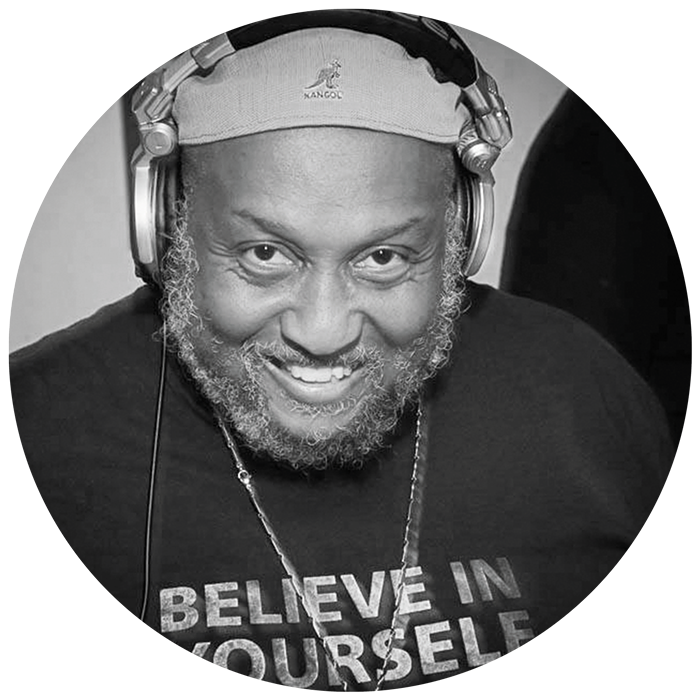I discovered Riz Rollins not too long after I settled in Seattle in the early 1990s.
He lived in a mother-in-law cottage (which is now gone) that was near the Harvard Exit theater (now gone) right behind an apartment building (also now gone) that my cousins lived in. He worked at Orpheum Records (gone) on Broadway, which was next to Siam Thai Cuisine and Jade Pagoda (both gone—the former relocated to Eastlake and the latter to restaurant heaven).
At the time, hiphop was in its Afrocentric and Daisy Age phase, and Riz, with his dreadlocks and idiosyncratic spirituality (it blended elements of the black church with black hippie open-mindedness) appeared to be Seattle's best representative of that progressive mood. The mood was defined by acts like the Jungle Brothers, A Tribe Called Quest, Queen Latifah, the Pharcyde, and, of course, De La Soul.
I eventually formed a lasting friendship with Riz, who was one of the most prominent black gay personalities in Seattle. He is now married to Rob Green, a nurse he met during a visit to Harborview Medical Center (their union happened three years before gay marriage was legalized in this state in 2012). Much of Riz's fame in the city is linked to his two popular shows on KEXP. One, Variety Mix, is on air on Mondays at 9 p.m., and the other, Expansions, is on air on Sundays at 9 p.m. The latter show, which is something of a sonic church (Riz is by education a theologian), has deep connections with the early days when he made a huge impression on me—a young, straight, black African discovering a new American city and ways of being in that city.
The first cool club I discovered in Seattle was Re-bar (which, amazingly, is not gone). Opened in 1990, it was not only a dance club, but also a bar and a theater, with deep roots in the gay performance community. Riz was a DJ at the club in the mid-1990s. His sets would transform Re-bar into a cultural laboratory for the creation of a brand-new race of Seattleites.
The city was between the 1990–1992 recession and the dot-com boom that began in 1995, a boom that initiated the first massive reconstruction of the city. The next boom was from 2002 to 2007, and the latest, which began in 2013, has no end in sight at the time of this writing. The mid-1990s were a transitional moment, a moment when there was enough uncertainty about the city's future that people like me, who loved dancing and drinking, could dream a little, and by moving to the music, perform the Seattle we wanted to live in and the kind of citizen we wanted to be.
The fact that the standard heterosexual coupling of straight clubs was almost totally dissolved during Riz's sets was liberating. The dance floor was not a meat market; if you wanted to hook up with someone, you could do so at the bar. But once on the floor, you were there for "everybody, everybody; everybody, everybody." Riz's sets, which were multicultural, multisexual, and multiracial, presented the ideal city.
These sessions had the kind of fearlessness that would, under normal circumstances, kill the career of a DJ. Riz did not stick to tunes that kept the floor packed, but followed an extemporaneous course that could only be appreciated globally, as a whole, at the end of the night. Some of the tunes he selected were common enough and easy to dance to; others were new and rocking the nightclubs in Chicago, Detroit, DC, Brooklyn, and South London; others sounded like that alien jazz in Chalmun's Cantina.
Now, the thing that these sessions at Re-bar revealed to me (and this thing was also expressed by the title of a novel that had a huge impact on me at the time, Josef Škvorecký's The Engineer of Human Souls) is the seemingly infinite plasticity of human culture. To explain this as clearly as possible, two things have to be separated: the social and the cultural. Humans are social, but I think this is a deeper and older side of our animality. We cannot be antisocial. We always need others. That is the kind of body we have. A body that moves and works with other bodies.
But culture, on the other hand, can change rapidly. This is its glorious plasticity. But if this plasticity is not recognized, culture is confused with nature and its hard, fixed, and genetic laws, and we impose these misperceptions of the natural on the social body. This has caused a lot of misery in the world.
What all of this means—and what Riz made so clear to me on those Friday nights, and something that has become the core of my thinking as a writer and culture critic—is that our modes of moving through the world can be altered, revised, or completely reinvented. Some people call this social engineering, but I call it cultural engineering. Social engineering sounds like eugenics, or something that happens in an operating theater. Cultural engineering has a different ring. It can happen on a dance floor.
• This piece appears in the 2018 Queer Issue as "That One DJ." See also: “That One Serial Killer” by Dan Savage, “That One Drag Queen” by Jinkx Monsoon, “That One Writer” by Sophia Stephens, “That One Coworker” by Trisha Ready, “That One Teacher” by Katie Herzog, “That One Parent” by Jing Jing Wang, "That One Roommate" by Christopher Frizzelle, “That One Radical Faerie” by Marc Castillo, “That One Songwriter” by Eli Sanders, “That One Filmmaker” by Chase Burns, and “That One Spouse” by Natalie Wood.














